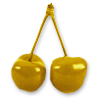The factory on the border


By Terrence Oblong
- 8356 reads
Scotland’s vote to become independent had caused chaos and confusion in many a backyard, but no yard was more confused than that of the Offal Factory, the meat processing plant that supplied offal for 90% of the haggis consumed in the world, and 87% of all meat used in black puddings.
‘Tis an offal day for offal, nobody dared pun, for the issue was far too serious.
The Offal Factory was situated on the Scotland / England border. Not just near the border, the border actually ran through the factory site. 51% of the site was on the Scottish side, and 49% on the English side. However, things weren’t that simple. Though the overall site was predominantly Scottish, the factory itself was predominantly English, 51% of it being situated south of the border. Not only was the site divided, so were it’s owners, Mr and Mrs Galbraith, the Scottish wife and English husband, who co-ran the factory.
The border line also ran straight through the gents toilet, 50% on the Scottish side, 50% on the English side, making every pee a test of your nationhood.
The factory was essential to the meat industry on both sides of the border and both governments claimed that the factory was theirs. Not only was it important to industry, it was of immense cultural significance. If the English won control of the factory they could impose a tax that would effectively wipe out the haggis. The Scottish could do the same to the black pudding. The very history of novelty offal-based meats hung in the balance.
Whichever side won, the Galbraiths knew, there would be a long, expensive lawsuit, followed by the imposition of vast swathes of taxes on the import of offal products, and most likely, restrictions on citizenship which would prevent half the workforce and one or other of the Galbraiths going to work. The result of this triple whammy would almost certainly be bankruptcy and the closure of the factory.
The factory entrance was a further complication. Exactly half of the entrance was on the Scottish side of the border, half on the English. It was impossible to enter the factory gates without driving through both countries simultaneously. Two new entrances had to be built, one on each side, in order to allow meat to be delivered and leave the premises without risking prosecution for border hopping.
The protestors had started to gather at midnight on the day that the “Aye” campaign won the referendum (Though a similar referendum had been lost just a year earlier, it was discovered that the main reason was the genuine Scottish nationalists didn’t like voting for a word which was far too English, when there was a perfectly serviceable Scottish alternative). On one side of the border Scots would gather with their ‘Save the Haggis banners, on the other the English with ‘Save the Black Pudding’.
Only the border kept the two sides from a nasty confrontation, marked out by a thin chalk line, which both sides of protestors pressed up against, like darts players trying to pinch a millimetre advantage by pressing their feet right up against the ockey.
However, the peaceful protests soon became hostile. On the first Friday night after the Aye vote, both sides of protestors had been drinking and the two mobs lobbed angry haggis and black puddings at each other.
The army had to be called out, both armies in fact, and as the dispute lingered on, both armies became permanent residents on the border, watching to ensure that the protests didn’t break out into violence. As the protest grew in size, so did the military presence. Soon there were tanks lined up on both sides of the border and the constant noise of helicopters and planes passing overhead.
The war started when a haggis lorry driver accidently left through the wrong exit. He tried to correct his mistake by turning right and driving straight back onto the north road without passing through the official border checkpoint and customs.
English border guards opened fire on the truck, trying to force it to stop.
The Scottish border guards, witnessing the shooting, returned fire. The English troops immediately fired back and within a matter of seconds the wayward driver of a haggis lorry had turned into the Offal Wars.
- Log in to post comments
Comments
brilliant - I hope there's
brilliant - I hope there's more to come?
- Log in to post comments
offal, but it's 50/50 whether
offal, but it's 50/50 whether it will last as long as haggis.
- Log in to post comments
I'm sickly obsessed with this
I'm sickly obsessed with this offal challenge. Right up my street. You've made meat more crucial and given it the significance it deserves.
- Log in to post comments
Comical
What a witty story, I really liked it. A great delivery, I hope there is more to come!
- Log in to post comments
Enjoying this Offal series. I
Enjoying this Offal series. I vote for a story about Tripe.... mmmm lovely.
- Log in to post comments
Jolono is a butcher, terrence
Jolono is a butcher, terrence, so you're talking to the experts!
- Log in to post comments
I'm an old hag and I vote for
I'm an old hag and I vote for haggis. Wi neeps and tatties!
- Log in to post comments


